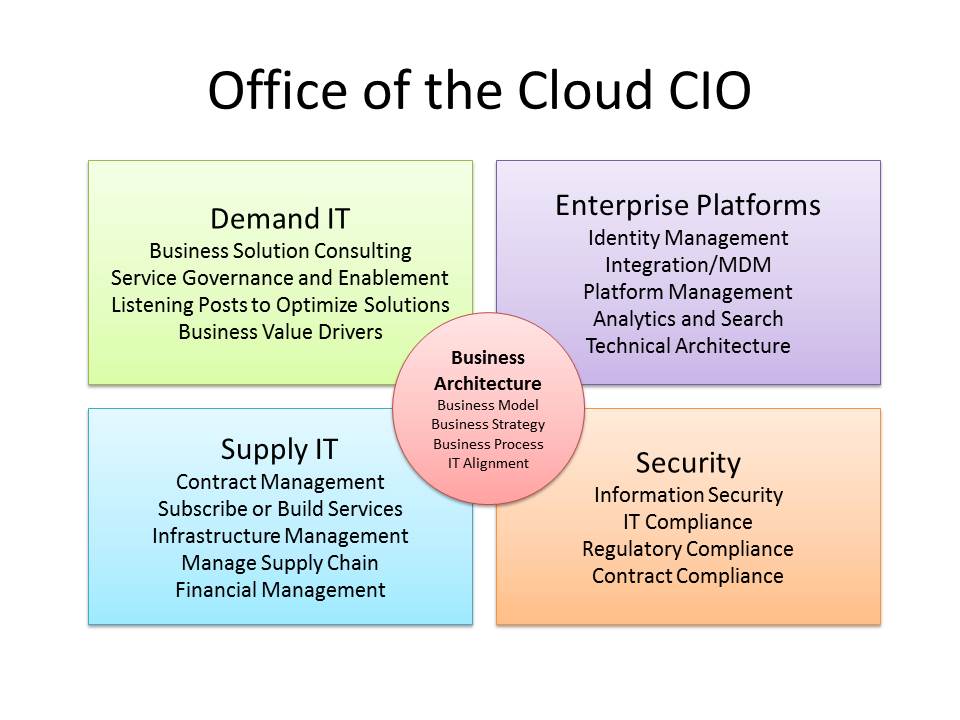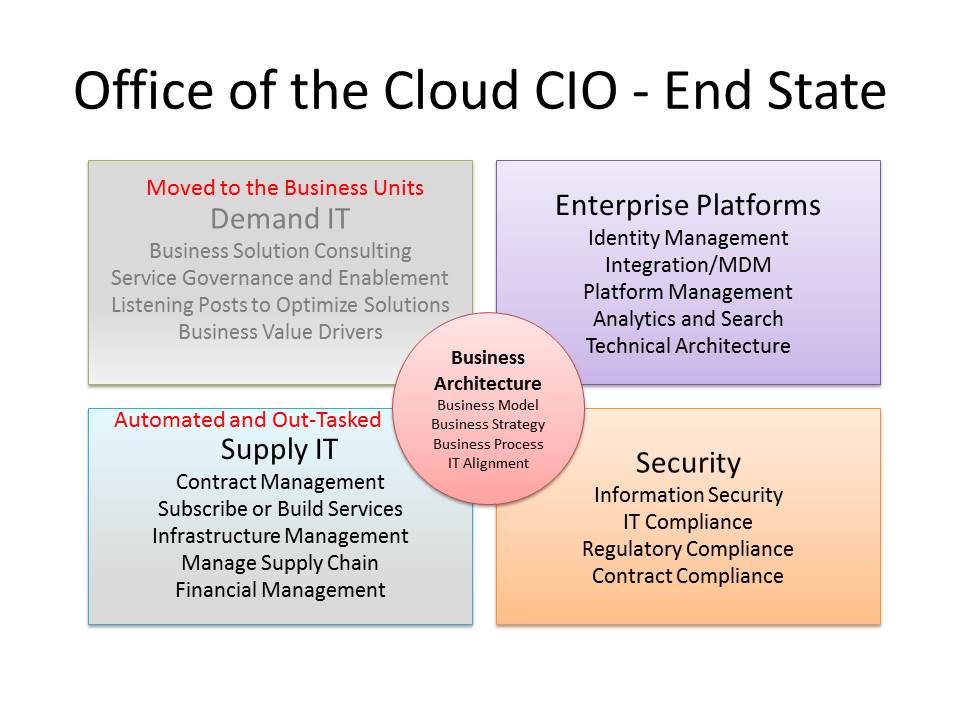Joseph Campbell (Mythologist, Scholar and inspiration for Star Wars) described disruption as, forces that will break your ego. At first the forced change can feel like hell. Its hell because everything we have perceived to be the understanding of our existence and our value within it, is getting destroyed. These changes only feel like hell because we cling to our egos. But if we allow our egos to be opened up and accept the change, we can have a peak-experience.
This idea has always struck me as an important piece of knowledge that I have tucked away since I read his books years ago when I was in high school. Its relevance in the context of how technology is impacting human beings ability to relate with one another is significant. On a macro level this is exactly what cloud computing has done to IT professionals and more importantly to how the Enterprise IT organization will serve the business.
In a previous article (The Great Transformation), I discussed how the Enterprise must transform to adapt to this new world of cloud computing. Now, I want to explore the possibilities of how an IS organization could be constructed after it moves away from Plan, Build, Run operations and shifts to a Demand Supply IT model. It’s important to understand because it will speak volumes about the challenges your organization will feel as it accepts and goes through this transformation.
Technical Towers to Service Delivery
Technical Towers to Service Delivery
Almost every Enterprise I have worked with or when I talk to other IT professionals about the construct of their organizations, say they have two major departments: Infrastructure and Applications. Traditional IT for sure. Generally these are led by high level IT executives reporting to the CIO. As you look at each of these hierarchies, below them are a chain of technology towers supporting specific technology domains.
If IT hopes to have the right kind of relationship with the business, the first thing that needs to be done is completely let go of the concepts of infrastructure and applications. You are now in the business of delivering services. It’s important because the end-user does not consume infrastructure and an application; they use services to provide business capabilities in the form of processes or functionality. You have to see this from the end-user perspective. It becomes an outside-in exercise, not the inside-out one that traditional IT has been delivering.
Office of the Cloud CIO
Demand IT
The Demand IT organization are essentially your business facing IT organizations. Their goal is to consult with the business and execute solutions based on their needs for functionality or process. This is also where the IT organization will leverage service management systems and broker platforms to access and deliver IT services from the IT supply. Value engineering and governance are the two main principles of this organization. Once your company is in a charge-back model, it will also be the organization that will help with understanding the cost of IT services and the business benefit gained. In total, this provides a view of business value. With purchase power in the hands of the business unit, governance shifts from centralized IT models to the Demand IT edge. This is where creativity and consultation will become the new employee profile for anyone working in this area.
Supply IT
Supply IT
Like any well run Supply Chain, the Supply IT organization is responsible for running the ERP for IT operations. Their goal is to create a pipeline of services that the business can consume. They will create an interface for the business to engage these service and provision with self-service. There has been a lot of conversation around the Cloud Brokerage, which is the essence of this interface. But that interface is not enough. There needs to be well rooted processes that allows for service demand to be released to the Supply IT organization. Overtime through policy and service templates this will become more efficient. In turn, the Supply IT organization will be the fulfillment center for service delivery.
For those in the manufacturing world this looks all too familiar, and IT should not try and re-invent the wheel here. They should be leveraging manufacturing best practices to build their standard practices. The application is different but the functional characteristics are all the same here.
The goal for anyone tasked with operating this part of the office, should be to have a system to process the delivery of services. Construct a financial model of the services in the form of a per-unit of measure for charge-back. This is critical for SKU’s in the service catalog. Develop a process for service lifecycle management. Once in place then the Supply IT organization will continue to make service delivery leaner and fit for purpose.
The Supply IT organization will work with the Enterprise Platforms organization to assure compliance and integration of services stood up in the service catalog.
Enterprise Platforms – “Cloud Core”
Enterprise Platforms – “Cloud Core”
This is the most technically focus IT organization in this new model. Their focus is compliance, integration, vertical enablement, and analytics. This is the glue that binds the service selection decisions made in any particular Line of Business department. If the governance of service selection and use is made by the business unit in partnership with the Demand IT organization, there needs to be an organization that can help integrate the solutions to create a loosely coupled suite that can manage business processes end-to-end.
Historically, IT organization had governance control because they owned the capital intensive budgets to stand up services. In response they deployed monolithic business suites to manage business operations end-to-end. Over time these same enterprises will find that bits and pieces of the suite are going to be opted out for Cloud services that delivered a more focused solution. This will be done because they can be acquired very quickly without IT’s support, and delivered as an OPEX opportunity. This disrupts the continuity that the monolithic suite provided. So the main task for the Enterprise Platforms department is to re-establish end-to-end service continuity and real-time analytics of its operations.
Information Security
Information Security
What can I say about this organization that isn’t already known? They are a critical group. It’s a real art to manage security for any enterprise. Balancing company culture where access and openness drives innovation, but can also introduce scenarios for tremendous damage. Security is a practice that is constantly being challenged. Where policies need to be reviewed constantly and where companies need to understand how employees engage each other, their data, and outside entities.
Cloud computing has created a real stir along with new collaboration technologies. Enough so that organizations like Cloud Security Alliance and other bodies are trying to get their arms around the challenges and provide frameworks for securing external services.
Information security will now extend their reach to reviewing contracts with cloud service providers, and vetting external hosting infrastructures for compliance before service engagements. Of course, the challenge is for IT to know in the first place what services are being used, since the business units are engaging them on their own. A solid system of audit is required. This is why the Demand Supply IT model is essential and a strong partnership with Information Security is so critical.
Business Architecture
Business Architecture
Business Architecture is what Enterprise Architecture was supposed to have delivered, but never quite did. This group’s function is to understand the company’s business model, the business strategy, and the processes and functions that deliver both. Understanding those blueprints will then help map the services that are fulfilling those processes and function. I also see this group having responsibility for content and collaboration. The reason for this is because both will be vehicles to measure, understand, and have active dialog around the dynamics in business architecture.
The Business Architecture group interconnects in function, with the four other primary IT organizations. Business Architecture will inform, collaborate, and be informed by the other IT organizations. Mapping services used to fulfill the business model and tracking the efficiency will also be a critical function. In many ways Business Architecture will serve as the QC department to business operations, strategy and ultimately its design. This overtime this will become a primary function and focus in the Office of the CIO.
More Changes in Future
More Changes in the Future
As this model matures, the new model of IT operations will change again. Once charge-back functions are in full swing, the governance has properly shifted to the Demand IT organization, the Demand IT organization will find itself well entrenched in the business of the departments they serve. At some point with the maturity of the IT supply chain system, it will make sense that the Demand IT organization will move officially into the department that they support. This is a significant change but a necessary one. It also represents a generational reality. The Internet generation is growing up and they will have the skills to take any technology and mold them to serve the departmental practice they serve. The separation between business practitioner and IT professional will become very blurred in the next 10 years. It’s important to recognize this and be prepared for a new highly technical knowledge worker.
IT Supply Chain Automation
IT Supply Chain Automation
The entire supply chain of IT overtime will become automated and built on best practice service delivery. I see the actual ERP of IT system being managed by a cloud provider and the operations from the business demand to the service delivery becoming highly automated. So when a business user requires a Cloud service they can have access to the right service instance and authorization almost immediately. DevOps teams can have complete environments built from preconfigured virtual models with policies that will assure their workloads land in an environment that meets data compliance requirements. In both cases completely automated, traceable, and compliant. This is the future of service delivery. No long project cycles to build services. It’s a move away from project portfolio management and a shift to service delivery management, with the business driving its own needs.
The new Office of the CIO represents the functional change that IT will have in relationship to the business and the framework for engagement. The transformation is significant and it represents the consumption economy of IT services in total. The focus and role of the CIO will become firmly part of the business and there will be no more questions about whether the CIO should have a seat at the table. The greatest challenge will be the change management exercise of moving the IT organization to this model. The CIOs that can champion this change and prepare their IT staff to embrace this new function of IT, will be the pioneering leaders we want in charge of our organizations. It starts with open mind and a willingness to transform.
(5864 Views)




1 Comment